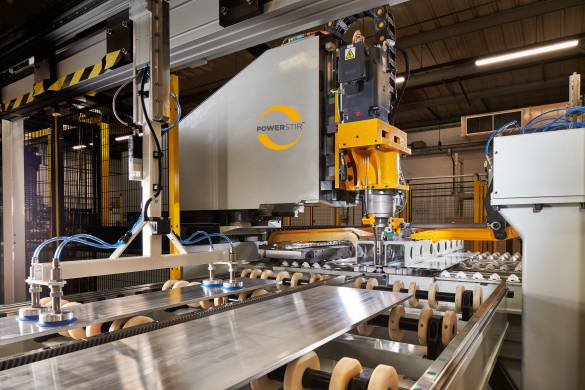News & Press
PTG Introduces Powerstir Dual Weld-Head Friction Stir Welding For Electric Vehicle OEMs

UK-based Precision Technologies Group (PTG), the manufacturer of the globally acclaimed Powerstir range of friction stir welding machines, has introduced a number of dual weld-head FSW models specifically for use in the volume production of automotive battery tray floor assemblies from extruded aluminium panels.
Ensuring a tight weld-flatness tolerance
PTG has long used its considerable knowledge of the FSW process to assist automotive OEMs in producing lightweight, robust and aesthetic components for battery electric vehicles (BEV) and plug-in hybrid electric vehicles (PHEV). Aimed directly at manufacturers of skateboard chassis structures, the dual weld-head process developed by PTG ensures that a tight weld-flatness tolerance is achieved during battery tray floor construction.
A tight weld-flatness tolerance is essential to ensure that each battery cell sits perfectly level within its housing. PTG Powerstir dual weld-head FSW machines provide an even and stable welding process – something that is achieved thanks to the company’s unique ‘matched’ dual-force control systems and balanced upper and lower head welding parameters. The result is exceptionally stable friction stir welding by both the upper and lower weld heads, producing matched weld seams with balanced heat input. This, in turn, minimises post-weld distortion and equips each welded assembly with a significantly improved flatness tolerance when compared to existing conventional single-side FSW techniques.
High-output production cell
As aluminium extrusion lines usually produce panels of 300 mm to 600 mm wide, PTG has also developed a fully automated, high-output Powerstir FSW production cell for the rapid friction stir welding of multiple extrusions, to create single structures for fabrication into battery tray floors. These structures are typically up to 2.4 metres wide.
“Our dual weld-head FSW technologies, whereby both sides of an extrusion are welded simultaneously, not only remove the time-consuming process of lifting and turning extrusions between welds, but also allow for equal heat dispersion which results in minimal distortion,” comments PTG Powerstir Regional Sales Director, Mark Curran.
In the PTG Powerstir dual weld-head FSW process, typically four to 12 individual child-part extrusions are brought together for assembly. Following gantry loading, each extrusion is automatically positioned and clamped ready for friction stir welding, after which the partially completed vehicle component is automatically repositioned, ready for the next panel to be welded in place.
Reduced wall thickness
“In addition to providing automotive OEMs with a state-of-the-art means of joining metals and achieving extremely high-strength results, it is also important to consider that in many instances, the use of friction stir welding also allows for reduced wall thickness – an important aspect in reducing vehicle weight,” adds Mark Curran. “As the friction stir welding process generates very little heat, the crystalline structure of the metal remains unchanged, retaining its original strength. There is no need for inert gas, no need for heat-treating post weld, and no requirement for additional surface finishing.”
PTG is widely considered to be a leader in the development of FSW technologies for transport applications. Organisations involved in the manufacture of aerospace components and the production of aluminium carriage panels for high-speed trains were among the first to recognise the benefits of Powerstir friction stir welding. Working with 5000 and 6000 Series aluminium alloys, and magnesium alloys from 3 mm to 6 mm in thickness, PTG is currently developing FSW processes for several automotive OEMs.
“In addition to building Powerstir machines specifically for the production of battery tray floor assemblies,” adds Mark Curran, “we are also creating FSW techniques for the production of coolant units, control box panels and car body panels, as well as body panels and components for commercial vehicles.”
Through the use of industry standard CNC systems, equipped with PTG Powerstir software, data-logging and interpolation technologies, 2-D welding – guided by laser tracking – can be carried out on precise tool paths, with force control ensuring consistent welded seams. QR codes are used to identify each extrusion before welding commences. Each completed panel is then DMC coded to identify the panel, for complete and ongoing traceability throughout the manufacturing cycle.
High-strength joints that are virtually defect free
Friction stir welding combines frictional heat with precisely controlled forging pressure to produce extremely high-strength joints that are virtually defect free. Due to the very low welding temperature, mechanical distortion is practically eliminated, with minimal Heat Affected Zone (HAZ) and an excellent surface finish. Friction stir welding transforms the parent metal from a solid to a plasticised state. This occurs during a process that involves mechanically stirring the materials to be joined together, to form a high integrity, full-penetration welded joint. The Powerstir FSW process is effective on flat plates, cylindrical components and even on parts of irregular thickness. Although used primarily for joining aluminium, the Powerstir process can also be applied to magnesium, copper, titanium and steel alloys.
Powerstir FSW manufacturing applications for electric vehicles include:
- Battery tray floor assemblies
- Battery trays and boxes
- Chassis and structural components
- Control box panels
- Vehicle body panels
- Brake regeneration systems
- Coolant units and heat exchangers







